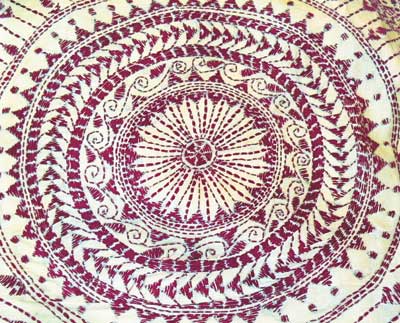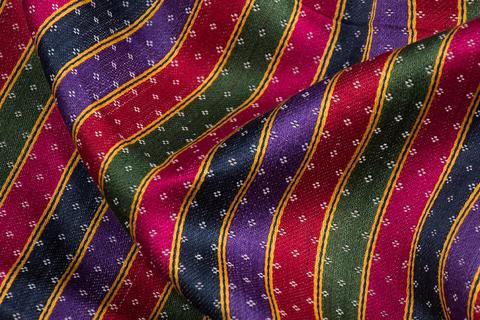There are thousands of weaving patterns in India because of the country’s climate and biodiversity. Indien’s textile tradition has been shaped by many factors, such as the climate, geography, local cultural customs, and raw material availability among others. In India, the fabric is made from a variety of raw materials, including silk, cotton, jute, and wool. India’s weaving traditions are dominated by cotton and silk. Assam, Banaras, Murshidabad, Surat, Kanchipuram, and Patan are some of India’s major silk weaving centers. Let us look at some of the most famous fabrics in India.

1. Kalamkari
Kalamkari is a 3000-year-old art, originated in Indian. Kalam means pen, and Kari means work, so it’s Pen-work. The Kalamkari artist uses a bamboo or date palm stick for the brush or pen with a bundle of fine hair attached to one end. However, these paintings are no longer just limited to canvas. They can be seen on silk and other materials as well. A kalamkari is a form of art that combines printmaking and painting. Organic pigments were used in the creation of these artworks. Mordants such as iron, tin, copper, or alum are used to prepare most colors. This type of painting can be found in a variety of forms and styles throughout the Indian subcontinent.

2. Kancheepuram
Craftsmen in Kanchi (Kanchipuram) near Bangalore, South India, have created a magnificent silk sari using Kanjeevaram silk, hence they are known as kanjeevaram silk. Kanjeevaram saree’s silk is extremely fine and durable, making it one of the most popular silks around the globe. For a South Indian woman, it is essential to have a kanjeevaram saree in her closet, as it the considered as their traditional outfit. Kanjeevaram silk sarees from India have a staggering variety of textures, colors, and designs. These sarees can be made in 10-12 days if they are simple.

3. Apatani
Originally from Arunachal Pradesh, the Apatani weave is named after the Apatani tribe. In Arunachal Pradesh, this tribe’s weaving techniques are far more advanced than the rest of the tribes. Weaved fabrics from Apatani are known for their geometric patterns, primarily regular designs and zigzag patterns, which can be seen on the fabric. Many people consider it an essential part of their wardrobe.

4. Muga Silk
India’s golden yellow silk, known as Muga, is the pride of Assam state. Antheraea assamensis, a semi-domesticated multivoltine silkworm, is used to produce it. Som and Soalu silkworms feed on the aromatic leaves and are reared on Tasar-like trees. Accordingly, the Muga culture is unique to the state of Assam and is a vital part of the state’s tradition and culture. Sarees, mekhalas, chaddars, etc., are made from Muga silk, a high-end product.
5. Patola Silk
Gujarat is known for its Patola silk saris, which are the pride of Gujarat. The resist dyeing technique was used to create these saris. As far as Patola saris are concerned, there are two types. Unlike the Patan patola, the Rajkot patola is only vertically resist-dyed (single ikat) (double ikat). Before weaving, the yarn is resist-dyed. In India, patola saris are well-known for their vibrant colors and geometric patterns interspersed with folk motifs. Due to the twill weave, the zari of the sari has a muted sheen. Intensely colored diagonal borders mimic the effect of gold enameling on the surface. For more casual occasions, Aashavali saris don’t have such spectacular use.

6. Kosa Silk
Because it comes in a variety of natural shades, including gold-pale, dark, honey, tan, beige, and creamy, Tussar silk or Kosa silk is prized for its purity and texture. Tussar silk saris are considered auspicious in Indian culture and tradition. The cocoons are raised on Arjun and Sal trees, making them a unique type of silk. A wide variety of colors are available as well as different natural motif designs. Maharashtra and Bihar are the two states that produce Tussar silk. It is also used to make home decor items such as bed covers and cushions, as well as clothing such as salwar kurtas and suits, as well as other clothing.

7. Banaras Silk
One of the most important silk sari-producing centers in India is Banaras. Her gold and silver brocades are legendary. Gold and silver wires that are as thin as hair can be made by heating the metal and passing it through small holes. With the help of silk yarn, these wires are woven together. Not only in India but also abroad, the Amru silk brocades of Banaras are legendary. Navrangi (nine colors), Jamdani, etc. are examples of other brocade types in the Banarasi sari collection. Banaras was once known for its cotton sarees and dress materials but gradually shifted to silk weaving during the Mughal period around the 14th century.
8. Bandhani
Gujarat’s Kutch region – Mandvi, Anjar, Bhuj, Dhamanka, Khavda, Bara, and Tera – produces some of the most famous Bandhani saris in the world. It involves the tying and dyeing of cotton or silk fabric. Depending on the number of shades in the final color scheme, the fabric may be tied and dyed multiple times. The process is simple, but it’s also time-consuming and challenging. Among India’s tie-dyed fabrics, Gujarat’s are among the best.

9. Batik
It’s no secret that Shantiniketan, also known as Tagore’s own country, is famous for its fine batik work. Batik art was previously taught at Visva Bharati University. The process of batik involves covering a part of the cloth with a wax coat and then dyeing the cloth. As a result, the cloth is decorated in a very unique manner. All over Shantiniketan, Batik designs are used to make saris, bags, dress material, scarves, dupattas, and many other types of garments.

10. Mashru Fabric
As well as its famous Patola sari, Patan, located 130 km from Ahmadabad, is known for a unique fabric called Mashru. There are many sari shops in Mashru. Mashru is a two-sided fabric, with silk on one side and cotton on the other. Due to Islamic law, it was initially only used by Muslim men, but Hindus began to use it later.

There’s so much to see and do in India that you might be taken aback. Every state has its own unique cultural identity, from the variety of delicacies to the fascinating customs, traditions, and festivals we celebrate. And the people’s clothing is a crucial part of that. Were you aware that not only Indian outfits but also the fabrics used to make them are unique to each state in India? Yes, from Kashmir to Kanyakumari, every region has its own handloom techniques that are used to weave a variety of distinctive fabrics. After knowing all this, we can say that India is truly blessed with its diversity in every field.
Other Articles:-






